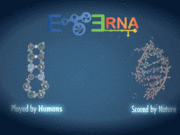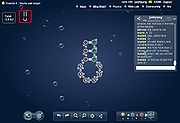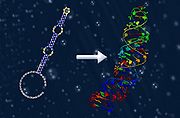EteRNA
Serious game review on the browser based, flash created game, eteRNA.
Game Information
The browser based game “eteRNA” is developed by scientists at the Universities of Carnegie Mellon and Stanford, and is an educational game focused on teaching and problem solving in the biological sciences. Primarily, eteRNA is a puzzle game that encourages users to build strands of RNA, an essential nucleic acid in the formation of life. The results of this game may ultimately have practical applications and uses in the real world, from allowing to a better understanding of disease and cell building to the building of nanomachines for use in medical science.
To aid in this, players, alone or in groups, may participate in challenges to solve puzzles based on existing models to better computer algorithms in creative ways, or in lab puzzles, which are real world design problems. Users may also vote on RNA designs for submission, which can be synthesized in labs for research purposes. The entire game is based on the idea of “crowdsourcing”, which is utilizing large groups of people, to yield meaningful results. Although there is no stated target age, it is designed to be played by anyone, regardless of background or knowledge of this particular scientific field.
Game Play and Interface
eteRNA plays very much like a simple point and click puzzle game, and uses a clean and colorful style to present the world to the player. The user is given a simple heads up display, allowing him or her to change what color, or base, to manipulate the presented strand of RNA, controls to zoom in and out, reset the strand, and other options to redo or undo actions. The player is also able to manipulate the strand by changing it to its natural state or the target mode to help solve the puzzle. There is also a chat window at hand, allowing the player to communicate with others as he or she solves puzzles. At its core, the player solves the said puzzles by clicking on the nodes on the strand to change the color, or base, to form bonds and new shapes, ultimately folding the strand into the desired pattern.
At the very beginning, the player is introduced to the game via a series of tutorials, walking users through the mechanics of the game and how to use the four bases of RNA - uracil, adenine, guanine and cytosine - to at first create simple shapes and folds. The player is then introduced to the strength of bonds to create folds that will hold as a natural shape, and tricks to getting these bonds to become stronger. As shown in the beginning of each stage, the player is tasked with the mission of solving that puzzle, how the shape should be, and even preconditions on how the strand must be formed. By completing these puzzles, the player is awarded points, which places him or her on a scoreboard, so there is an element of competition to these challenges as well. Complementing that, the player is able to communicate with others playing the game, relaying information as to what they are doing or coordinating on puzzles as well.
As mentioned earlier, eteRNA has two types of puzzles: challenge puzzles and lab puzzles. The challenge puzzles of the game concentrate on tasking the player in folding RNA into target shapes presented at the beginning of each puzzle. The purpose, as explained by the developers, is to allow the player to acclimate to the problem solving required in the puzzles and allow for better insight as to how these threads bond and fold. Not only that, but because such problems can consume a vast amount of time to solve using traditional computer models and methods, breaking it up into smaller problems amongst many users will yield better, faster, and even creative, results that these models would have been unable to produce. The player may also submit his or her solutions to these puzzles, so the developers can produce an algorithm to test against their existing programs.
The other type of puzzle available in the game is the lab puzzle. These games allow the player, or a group of players, to design and test RNA sequences that can work in nature. It functions exactly as the rest of the game does, but this one also allows for experimenting with folding the strands. Users are as well able to vote for the best designs that individuals or groups come up with, and for which strands fold the best. These winning designs will then be synthesized in an actual lab to test if it is a possible shape in nature, and then stored in an ever growing library of synthetic RNAs that have not as of yet been discovered in nature. More challenging puzzles, as a result, are presented to players to solve.
Overall the elements of the game are simple, yet intuitive. The rules of the game allow for freedom to create as the player wishes, but within a certain boundary imposed by the game that keeps the player informed as to how to complete the given task. Although highly scientific in nature, it is presented in such a way that it is easy to understand by anyone, to the players who do not have a background in biology to those who are perhaps on their way to becoming a scientist in the field. The game play itself is also easy to learn and understand, with the tutorials at the very beginning clearly elucidating the nature of the game and its mechanics. And to those who are so inclined, the challenge of competing with other players to earn more points and conversely work with others to overcome difficult challenges is as well here and a well implemented mechanic. This is a game, however, that cannot be fully completed. It is an ongoing process, solving more and more puzzles, but at the same time, producing viable results and providing invaluable data to the developers for the betterment of all in the long term.
Educational Potential
eteRNA offers a level of problem solving that increases in difficulty as the player progresses with each successive stage. It is absolutely a viable tool that can be used to teach students about the building and folding of RNA strands in a fun and interactive way. While the level of critical thinking involved in this game can vary, the ability to see patterns and think creatively to interpret the problem and those patterns, are very much important in solving the presented challenges. As well, even though the amount of knowledge needed for this game is not very deep, however, it is perhaps what makes this game much more accessible to a wider audience than what a more scientifically technical one would have been able to achieve.
Overall, eteRNA presents interesting challenges in a fun and interesting manner. To those who are interested in the scientific world it is a joy to play, whereas the puzzle style elements and colorful visuals will appeal to anyone with a passing interest in games. With the feature that allows designs to be submitted for use in the real world, it is an even greater motivator for students and casual players alike to contribute to a worthy endeavor and even learn about an important aspect of life, its components and the world at large.




